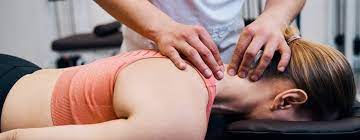

If you have ever caught yourself hunched over your laptop, craning your neck forward like a turtle, you are not alone.
Forward head posture (FHP) is a common issue in our tech-heavy world, and it can lead to neck pain, headaches, and long-term spinal issues.
But do not worry, physiotherapy has your back—quite literally.
In this article, I will discuss how physiotherapy helps correct forward head posture, break down the techniques used, and offer tips to improve your posture for good.
In This Article:
- Introduction to Forward Head Posture
- The Role of Physiotherapy in Correcting Forward Head Posture
- Physiotherapy Techniques for Realigning the Neck
- Exercises and Stretches Recommended by Physiotherapists
- Real-Life Examples: Physiotherapy Success Stories
- Conclusion: Long-Term Solutions and Tips for Maintaining Good Posture
What is FHP?
Forward head posture occurs when the head juts out in front of the body’s natural alignment.
Instead of having the ears aligned over the shoulders, they sit forward, creating strain on the neck and upper back.
Studies show that this posture places immense pressure on the cervical spine, increasing strain by up to 60 pounds when the neck is flexed at a 60-degree angle.
This can lead to conditions like cervicalgia, tension headaches, and even cervical spondylosis (Hansraj, 2014).
Physiotherapy offers an effective, non-invasive way to correct this posture and alleviate the associated discomfort.
The Role of Physiotherapy in Correcting Forward Head Posture
Physiotherapy plays a crucial role in diagnosing and treating forward head posture.
Physiotherapists conduct detailed assessments, often using a craniovertebral angle measurement to evaluate the extent of the posture deviation (Physiopedia).
These assessments are key to tailoring treatments specific to each individual’s needs.
For conditions like cervicalgia (neck pain), physiotherapy incorporates a range of techniques including soft tissue mobilization and cervical traction to alleviate pain and restore proper alignment.
In cases of more chronic issues, like cervical spondylosis, physical therapy aims to improve mobility, reduce inflammation, and strengthen the supporting muscles of the cervical spine.
The goal is to not only correct the posture but also prevent recurrence.
Physiotherapy Techniques for Realigning the Neck
So, how exactly does physiotherapy help?
Let us dive into some of the core techniques:
Cervical Retraction Exercises: One of the most effective exercises for correcting forward head posture is the cervical retraction, which involves pulling the head back and aligning it with the spine. This exercise is essential in reducing the excessive curve in the cervical spine that results from prolonged forward head positioning.
Myofascial Release: Physiotherapists often use myofascial release to target the tight muscles contributing to forward head posture, such as the upper trapezius and levator scapulae. This technique helps relieve tension, allowing for greater mobility and improved alignment.
Strengthening Exercises: Strengthening the deep cervical flexors is crucial. These muscles, when underactive, contribute to forward head posture. Exercises like chin tucks and resistance band training target these muscles, helping bring the head back into proper alignment. Strengthening the rhomboids and trapezius muscles also helps stabilize the upper back, creating a solid foundation for neck alignment.
Cervical Traction: For more severe cases like cervical spondylosis, physical therapy treatment includes traction techniques to relieve nerve compression and enhance mobility (Verywell Health). This helps reduce symptoms such as stiffness and pain, providing relief while improving posture.
Exercises and Stretches Recommended by Physiotherapists
Physiotherapists recommend several exercises and stretches to counteract forward head posture:
Chin Tucks: This simple but effective exercise activates the deep neck flexors. It’s easy to incorporate throughout the day—just tuck your chin slightly and pull it straight back, as if making a double chin. This movement helps realign the head over the spine.
Thoracic Extension: This stretch focuses on opening up the chest and extending the upper back, counteracting the forward curvature often seen in those with FHP. Performing this stretch over a foam roller can enhance its effectiveness.
Pectoral Stretch: Tight chest muscles can pull the shoulders forward, contributing to neck misalignment. A pectoral stretch performed against a wall or in a doorway helps loosen these muscles, making it easier to maintain proper posture.
Isometric Neck Exercises: These exercises involve holding the neck in a neutral position while applying resistance, either with a hand or a resistance band, to activate and strengthen the neck stabilizers. Physiotherapists often prescribe these to enhance muscle control and alignment.
Physiotherapy Success Stories
Let us look at Jane, a 35-year-old office worker who spent long hours at her desk.
She began experiencing frequent headaches and neck stiffness.
After consulting a physiotherapist, she was diagnosed with forward head posture.
The therapist prescribed a mix of cervical retraction exercises and thoracic mobility work to target her neck and upper back.
Within six weeks, her headaches reduced significantly, and her neck mobility improved.
Another example is Jude, a 50-year-old suffering from cervical spondylosis.
His physiotherapist included traction and myofascial release in his treatment plan to alleviate pain and restore proper alignment.
Jude complemented his in-clinic sessions with home exercises like chin tucks and thoracic stretches.
Over three months, his pain levels decreased, and his posture was visibly improved.
Long-Term Solutions and Tips for Maintaining Good Posture
How to fix forward head posture fast? Well, this could be achieved through physiotherapy requires a mix of targeted exercises, muscle release techniques, and strengthening routines.
The key is consistency; exercises like chin tucks and pectoral stretches should become part of your daily routine.
Additionally, making ergonomic adjustments at your workstation—such as raising your monitor to eye level and using a supportive chair—can go a long way in maintaining proper posture.
If you experience symptoms like chronic neck pain, headaches, or restricted movement, seeking professional help is essential.
Physiotherapists are trained to create personalized treatment plans that address the root cause of your posture issues.
Whether it is cervicalgia physical therapy treatment or exercises for neck arthritis, they will have the right approach for you.
So, while forward head posture may seem like a modern-day curse, physiotherapy offers effective and proven ways to correct it.
By combining professional treatment with mindful habits, you can keep your head held high—literally and figuratively!
References:


